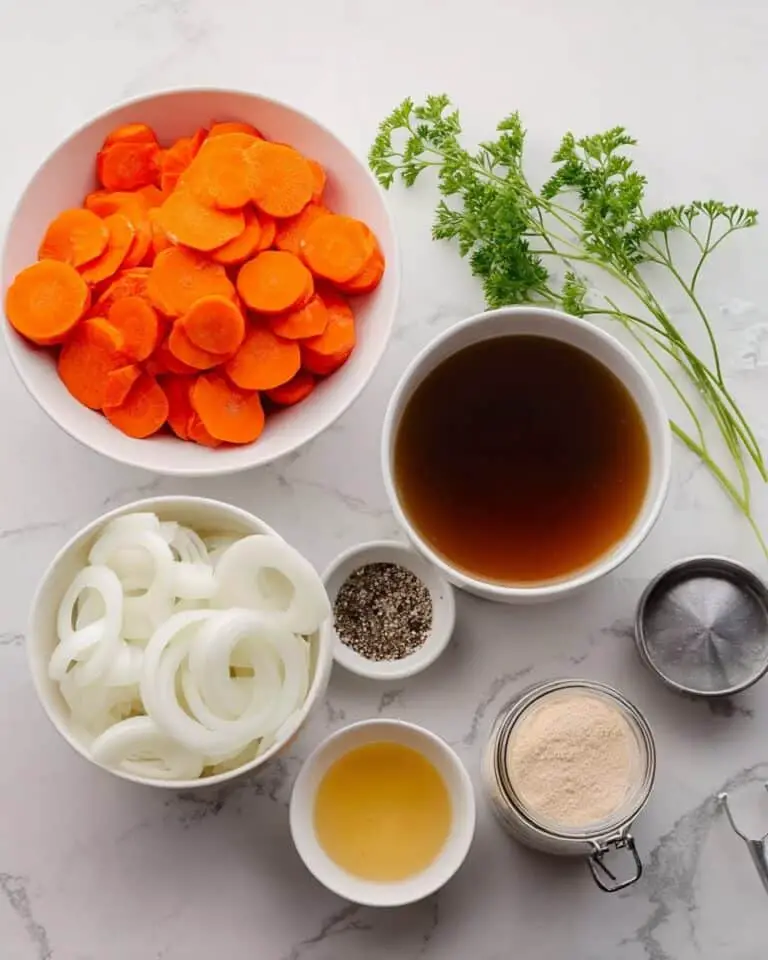If you have ever craved that soothing, umami-rich warmth from a Japanese restaurant but wanted to skip the wait, this Simple Miso Soup Recipe is exactly what you need. It perfectly balances the velvety smoothness of silken tofu, the earthiness of shiitake mushrooms, and the gentle tang of miso paste, all coming together in a comforting, nourishing bowl. This soup is not only incredibly easy to prepare but also incredibly satisfying, making it a staple for anyone wanting a quick yet authentic taste of Japan right at home.
Ingredients You’ll Need

Every ingredient in this Simple Miso Soup Recipe plays a crucial role in crafting its delicate flavors and textures. They are straightforward, easy to find, and provide a beautiful harmony that makes this soup both comforting and refreshing.
- Extra firm tofu: Pressing and cubing it adds a creamy, gentle texture that soaks up the broth beautifully.
- Vegetable broth: The soul of the soup, giving a savory base without overpowering the miso flavor.
- Shiitake mushrooms: Their rich, woodsy taste enhances the depth and adds a satisfying chewiness.
- Scallions: These bring a bright pop of color and a subtle fresh bite that lifts the soup.
- White miso paste: The star of the dish, it infuses everything with that signature salty, slightly sweet umami.
- Soy sauce: Adds an additional layer of savory complexity and saltiness.
- Ginger: Just a touch to warm the palate and add that comforting zing.
How to Make Simple Miso Soup Recipe
Step 1: Press and prepare the tofu
Start by removing the tofu from its packaging and placing it in a shallow bowl. Layer a paper towel on top, then a flat plate, and finally something heavy like a cast-iron skillet. This simple trick presses out the excess water, ensuring your tofu has the perfect texture and won’t water down the soup. After about 15 minutes, drain the water and chop the tofu into bite-sized cubes ready to soak up the broth.
Step 2: Prep your mushrooms and scallions
While your tofu is pressing, remove the stems from your shiitake mushrooms and slice them thinly for tender bites. Chop the scallions to bring that fresh, green brightness to the soup. This prep work sets the stage for the layers of flavor to come.
Step 3: Bring the broth to a boil
Pour your vegetable broth into a soup pot over medium-high heat and bring it to a gentle boil. This will awaken the flavors and create the perfect temperature to dissolve your miso paste later on.
Step 4: Dissolve the miso paste
Before adding miso directly to the pot, ladle out about one cup of the boiling broth into a small bowl. Add the white miso paste and stir until completely dissolved. This technique gently incorporates the miso, preserving its delicate flavors and nutrients.
Step 5: Cook mushrooms and add seasonings
Add your sliced mushrooms to the boiling broth and cook for about 5 minutes on medium-high heat. Then reduce the heat to a simmer and stir in the dissolved miso mixture, soy sauce, freshly chopped scallions, and ginger. Let all the flavors mingle together, simmering gently for another 5 minutes while the tofu cubes can be added in to warm through if desired.
Step 6: Serve and enjoy
Once the soup has a lovely aroma and the ingredients have melded perfectly, it’s ready to serve piping hot. This savory, comforting bowl will warm you from the inside out — truly an easy joy to savor any day of the week.
How to Serve Simple Miso Soup Recipe

Garnishes
Simple garnishes like a sprinkle of toasted sesame seeds, a few thin slices of fresh scallion, or even a tiny drizzle of chili oil can enhance your miso soup visually and flavor-wise. These additions add texture and a hint of new flavor dimensions while keeping things authentic and inviting.
Side Dishes
Pair this Simple Miso Soup Recipe with steamed rice, a fresh cucumber salad, or perhaps some crispy tempura for a balanced and delightful meal. The lightness of the soup contrasts beautifully with sides that are crunchy or subtly flavored, creating an inviting dining experience.
Creative Ways to Present
Elevate your presentation by serving miso soup in traditional Japanese-style lacquer bowls or simple rustic ceramic bowls for homey charm. A wooden spoon or chopsticks alongside the bowl brings an added cultural touch that makes every spoonful feel special.
Make Ahead and Storage
Storing Leftovers
If you have any leftover miso soup, you can store it in an airtight container in the refrigerator for up to 3 days. Because of the delicate nature of miso paste, it’s best to keep the tofu separate if possible to maintain its texture, adding it fresh when reheating.
Freezing
Freezing miso soup is generally not recommended as the texture of tofu can become rubbery and miso’s flavor can degrade. For the best taste and quality, enjoy this soup fresh or refrigerate rather than freeze.
Reheating
To reheat your miso soup, warm it gently on the stove over low heat. Avoid boiling, as high temperatures can break down the miso’s delicate umami and alter the tofu’s texture. Stir occasionally until heated through and enjoy immediately for the fullest flavor.
FAQs
Can I use other types of miso paste?
Absolutely! While white miso is milder and sweeter, you can experiment with red or mixed miso pastes for a more robust, deeper flavor. Just adjust the quantity since darker misos are saltier and stronger.
Is it possible to make this soup vegan?
Yes! This Simple Miso Soup Recipe is naturally vegan since it uses vegetable broth and plant-based ingredients like tofu and mushrooms. Make sure the soy sauce you use is also vegan-friendly.
What can I substitute for shiitake mushrooms?
If shiitake mushrooms aren’t available, cremini or button mushrooms work well too. They provide a mild earthiness that complements the soup but won’t overpower the delicate miso flavor.
Can I add noodles or rice to this soup?
Definitely! Adding cooked soba noodles or a handful of cooked rice can make this miso soup more filling and turn it into a satisfying light meal. Just add them in when you add the tofu so everything is warm and ready to eat together.
How salty is this soup?
The soup has a gentle saltiness thanks to the miso and soy sauce, but it’s well balanced and never overwhelming. You can adjust the soy sauce amount or choose a low-sodium miso paste if you want something milder.
Final Thoughts
There is something truly special about a bowl of homemade miso soup that just feels like a hug in a bowl. This Simple Miso Soup Recipe is easy enough for weeknight dinners yet impressive enough to share with friends or guests. I hope you’ll give it a try and discover how effortlessly delicious and comforting a bowl of miso soup can be when made with love in your own kitchen.
PrintSimple Miso Soup Recipe
This simple miso soup recipe allows you to enjoy a warm, comforting bowl of traditional Japanese miso soup right at home. Featuring hearty shiitake mushrooms, fresh scallions, and protein-rich tofu, it combines savory miso paste and vegetable broth for a delicious and nutritious meal or starter that’s ready in just 25 minutes.
- Prep Time: 15 minutes
- Cook Time: 10 minutes
- Total Time: 25 minutes
- Yield: 6 servings
- Category: Soup
- Method: Stovetop
- Cuisine: Japanese
- Diet: Vegetarian
Ingredients
Soup Ingredients
- 1 package (12 ounces) extra firm tofu
- 5 cups vegetable broth
- 3 cups shiitake mushrooms, stems removed, sliced
- 4 scallions, chopped
- ¼ cup white miso paste
- 1 tablespoon soy sauce
- ½ teaspoon ginger
Instructions
- Press the Tofu: Remove the tofu from its package and place it in a shallow bowl. Layer a paper towel on top, then a flat plate, followed by something heavy like a cast-iron skillet to press out excess water. Let it sit for 15 minutes. After pressing, drain the accumulated water and chop the tofu into cubes.
- Prepare the Broth: Pour the vegetable broth into a soup pot and bring it to a boil over medium-high heat.
- Prepare Vegetables: Remove stems from the shiitake mushrooms and slice them. Chop the scallions into small pieces.
- Dissolve the Miso Paste: Once the broth is boiling, ladle out about 1 cup into a small bowl. Add the white miso paste to the bowl and stir until the miso is completely dissolved, ensuring a smooth mixture to prevent clumping when added back to the pot.
- Cook Mushrooms: Add the sliced mushrooms to the boiling broth and cook on medium-high heat for 5 minutes to soften and release their flavor.
- Simmer and Add Seasonings: Reduce the heat to low to maintain a simmer. Stir in the dissolved miso paste, soy sauce, ginger, scallions, and tofu cubes gently. Let the soup simmer for another 5 minutes to allow flavors to meld.
- Serve: Once simmered, remove from heat and serve the miso soup hot. Enjoy this nourishing and flavorful dish!
Notes
- Pressing the tofu removes excess moisture and prevents the soup from becoming watery.
- Do not boil the miso paste directly as high heat can destroy its delicate flavors and beneficial probiotics.
- You can substitute shiitake mushrooms with other mushroom varieties like enoki or button mushrooms.
- Adjust ginger and soy sauce quantities to taste, especially if watching sodium intake.
- Use white miso paste for a milder, sweeter flavor or red miso for a stronger, saltier taste.








